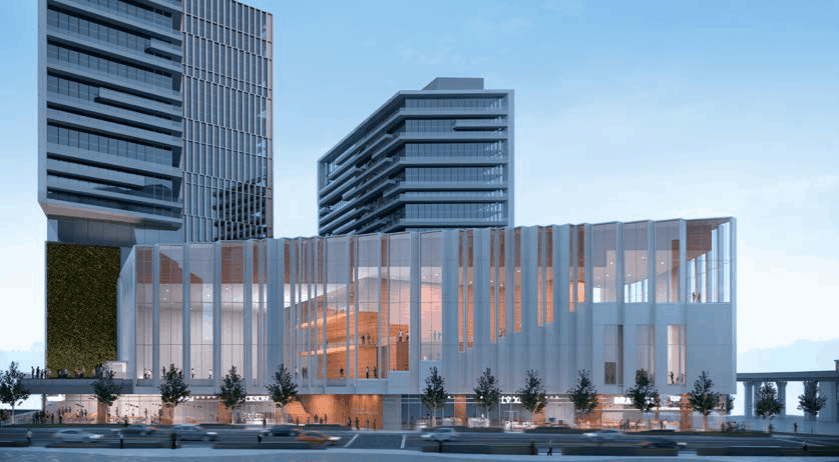Throughout my years covering the arts in the DC area, I have often heard that Fairfax County is a wasteland, a desert, no place for the creative theater artist. A locale with few outlets for professional theater artists to take a stage in their own community. Often a place to live in and then cross some political or geographic boundaries to perform–a locale where zoning made new professional theater venues not so easy to establish.

But, it seems the new Tysons development and the visions of private developers are having an impact. First off, some projections indicate that in just 30 years, Fairfax County’s new urban downtown, Tysons, may have a population of 200,000 people working there, with more than 100,000 people living there (compared with 17,000 currently).
So, what next for the arts in Fairfax County? In gathering background for this article, I learned that Fairfax County has been working in partnership with developers to bring cultural components and amenities to the new Tysons and throughout Fairfax County. Much seems connected to the Silver Line Metro, as well as new energy and ideas.
And now there is a flurry of development of new arts venues in Fairfax County. While the DC area’s largest jurisdiction in population, and with the highest per capita income in the inner suburbs, until recently Fairfax County (unlike other DC-area jurisdictions) was not in the forefront of new performing arts venues. However, now there are efforts to rethink old zoning codes in order to repurpose vacant offices and reposition commercial buildings in the County for non-traditional uses.
Since the arts are expected to add to the success of new privately funded density in the burgeoning Tysons area–served by the McLean, Tysons Corner, Greensboro, and Spring Hill Metro stops on the Silver Line–the arts are no longer a side aspect of county development.
With that, I went to the leadership of ARTSFAIRFAX to learn more. ARTSFAIRFAX is the organization that helps support the arts and provides a voice for the arts in Fairfax County.
For Beth Cabrera, ARTSFAIRFAX Board Chair, “ARTSFAIRFAX plays an extremely important role in our community, helping to support the arts, which enhance our quality of life and contribute to the economy. It’s exciting to work with an organization that does so much for our county by advocating for the arts, developing new arts venues, increasing participation in the arts, and growing arts organizations and programs.” Cabrera holds a Ph.D. and is Senior Scholar, Center for the Advancement of Well-Being, at George Mason University.

Linda Sullivan, the CEO and President of ARTSFAIRFAX, said this: “We’re seeing an increased recognition to the value the arts bring to our region. The arts attract and inspire a strong workforce, help educate our children, entertain us, and enhance our communities.”
According to Sullivan, there are about 250 arts organizations, large and small, in Fairfax County. A study developed by Americans for the Arts in collaboration with ARTSFAIRFAX indicated that over $270 million is generated annually in economic activity from the arts and culture industry in Fairfax. Additionally, over $9 million of local government revenue is generated and over 6,200 full-time equivalent jobs are supported.
It’s clear that the arts are a big business in Fairfax County. “We are seeing an increased recognition to the value the arts bring to our region,” added Sullivan.
Yet Sullivan and others in the arts community insist that more can be accomplished. “Fairfax County has always had many outstanding arts organizations but with a shortage of arts venues they have not been as visible as they might be in other communities,” said Sullivan. For smaller non-profit arts and cultural organizations, she observed that “the lack of professional arts venues that can accommodate audience growth, and lower than regional average financial support that can help an organization enhance its programs and productions,” have been challenges.
“Now, with a large, diverse and growing population, it’s the cultural infrastructure that will help communities, and the entire county, to thrive,” Sullivan added. Fairfax County is now working to match other communities with over 1 million populations which may have larger cultural facility infrastructures.
In the Tysons area, as an example, there is heightened interest in developing arts and cultural facilities. Sullivan noted Capital One’s Capital One Center in Tysons, expected to be completed in 2020-2021. It will offer a 1500-seat performance venue, a 280-seat black box theater, two large classrooms, and a rooftop greenspace that can offer outdoor music and small performances. The Capital One Center is near to the Metro Silver Line McLean stop.
More arts development is anticipated in Tysons with a performing and visual arts venue in early planning for The View development near the Spring Hill Silver Line metro stop. The View developer, Clemente Development, is seeking to provide needed mid-sized performing venues including 199-seats and 500-seats, to fill out a capacity range needed by the Fairfax performing arts community. The expected stand-alone arts venue will be part of the overall The View development.
There is also development beyond Tysons–for instance, a new 18,000-square-foot arts venue planned in Herndon near the Dulles Corridor and close by Reston.
According to Sullivan, “The arts have a three-pillared support system: government, private funders, and audience support. We’re seeing an increased recognition among all three as to the value the arts bring to our region to attract and inspire a strong workforce, to educate our children, to entertain us, and to enhance our communities – for residents, employees, visitors, and businesses,”
Ending our conversations, Sullivan added this; “I invite all in the DC region and beyond to get to know our broad, diverse, and vibrant arts scene in Fairfax County. With over so many arts organizations and artists, and over 100 festivals across the County and cities of Fairfax and Falls Church…we’re more than you may know, and there’s more to come with this needed, new development. I think you’ll like what you see!”
It seems clear that in Fairfax County, there is a fresh sense that a vibrant arts scene can only help with the success of any new development. This seems not unlike say the new Wharf area in Southwest DC or the burgeoning gentrifying DC H Street corridor or the energy of DC’s 14th Street area with its performing arts venues and foodie hangouts as centerpieces.




